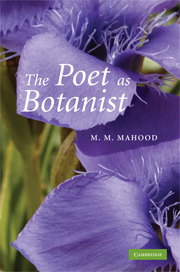Book contents
- Frontmatter
- Contents
- List of illustrations
- Acknowledgements
- A note on quotations
- Introduction
- 1 Primroses at Dove Cottage and Down House
- 2 Erasmus Darwin's feeling for the organism
- 3 Crabbe's slimy mallows and suffocated clover
- 4 John Clare: bard of the wild flowers
- 5 Ruskin's flowers of evil
- 6 D. H. Lawrence, botanist
- 7 Poetry and photosynthesis
- Index of persons
- Index of plants
2 - Erasmus Darwin's feeling for the organism
Published online by Cambridge University Press: 22 September 2009
- Frontmatter
- Contents
- List of illustrations
- Acknowledgements
- A note on quotations
- Introduction
- 1 Primroses at Dove Cottage and Down House
- 2 Erasmus Darwin's feeling for the organism
- 3 Crabbe's slimy mallows and suffocated clover
- 4 John Clare: bard of the wild flowers
- 5 Ruskin's flowers of evil
- 6 D. H. Lawrence, botanist
- 7 Poetry and photosynthesis
- Index of persons
- Index of plants
Summary
A flower less like the primrose than the canna lily is hard to imagine. With its shield of high-held leaves and casque of huge blossoms, Canna indica is a piece of conspicuous expenditure in municipal gardens, suggestive of well-tended greenhouses and an army of bedders-out. Today we think of it as a typically Victorian plant; most at home, perhaps, in Mumbai or Calcutta, where ordered ranks of it form an imperial guard before the monuments of the Raj. Yet it reached Europe from the other – the West – Indies at the time of the Discoveries. It soon acclimatised in southern Europe, and sometimes shines out from the pages of a seventeenth-century florilegium. But Gerard could not coax it to produce its ‘fantastic’ flowers in his London garden, where he found it ‘very impatient to endure the injury of our cold climate’.
Cannas would have been even more impatient of the Swedish climate. Carolus Linnaeus had not seen one in flower at the time he devised his classification of plants according to what he called the sexual system: one based, that is, on the number and arrangement of stamens. Linnaeus was not the discoverer of plant sex. Gardeners had always known that, to obtain fruit from certain plants, pollen had to be transferred from individuals carrying it in their flowers to the stigmas of other individuals of which the flowers had no pollen.
- Type
- Chapter
- Information
- The Poet as Botanist , pp. 49 - 81Publisher: Cambridge University PressPrint publication year: 2008



